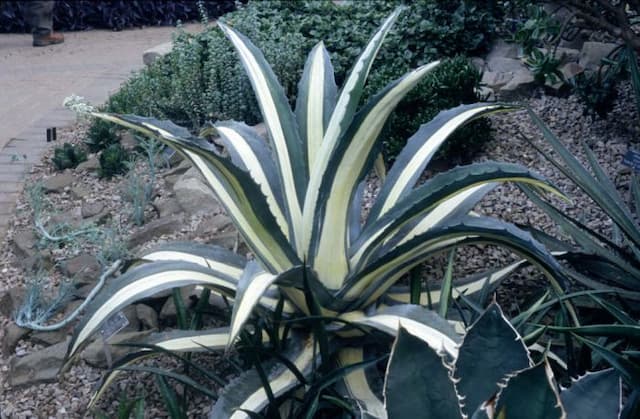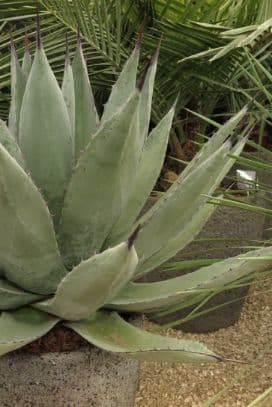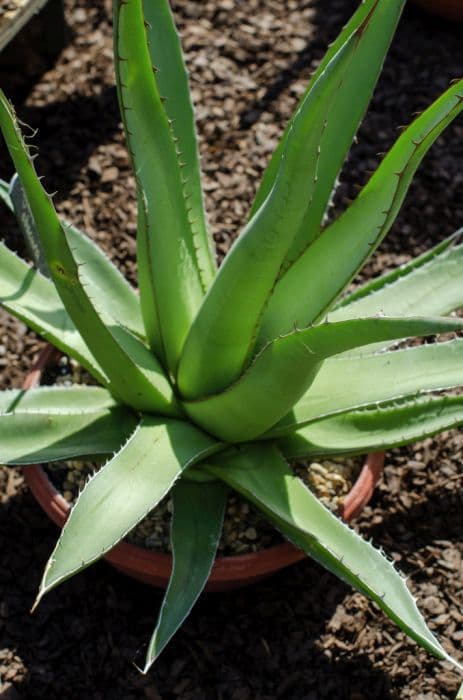Dragon Tree Dracaena marginata 'Bicolor' (v)

ABOUT
The Dracaena marginata 'Bicolor', also known commonly as the Dragon Tree, is a distinctive plant with a striking appearance. It has slender, upright canes that are topped with narrow, arching leaves. The leaves of the 'Bicolor' variety have a characteristic coloration; they are green with red or pink stripes running along their edges, giving them a vibrant and decorative appearance. The contrast between the red or pink and green adds an exotic touch to the plant. The leaves are long and pointed, creating an overall graceful and elegant shape. The texture of the leaves is smooth, and they have a slightly glossy finish which catches the light, enhancing the vividness of their colors. This variety of Dragon Tree has a somewhat palm-like silhouette, thanks to its tufted foliage that sprouts from the top of its cane-like stems, contributing to its popularity as an ornamental houseplant.
About this plant
 Names
NamesFamily
Asparagaceae
Synonyms
Dragon Tree, Madagascar Dragon Tree, Red-Margined Dracaena, Bicolored Dracaena
Common names
Dracaena marginata 'Bicolor'
 Toxicity
ToxicityTo humans
The Dragon Tree is generally considered non-toxic to humans, and accidental ingestion typically does not result in severe poisoning. However, chewing or ingesting parts of the plant may occasionally cause mild reactions such as stomach upset or diarrhea due to its saponins content. It is still advisable to prevent children from ingesting the plant as individual sensitivities can vary.
To pets
The Dragon Tree is toxic to both cats and dogs due to compounds known as saponins. If pets ingest part of the plant, they may exhibit symptoms such as vomiting, drooling, loss of appetite, and weakness. In severe cases, ingestion can lead to depression and dilated pupils. It is important to keep this plant out of reach of pets and seek veterinary attention if accidental ingestion occurs.
 Characteristics
CharacteristicsLife cycle
Perennials
Foliage type
Evergreen
Color of leaves
Mixed
Height
6-15 feet (1.8-4.5 meters)
Spread
3-8 feet (0.9-2.4 meters)
Plant type
Shrub
Hardiness zones
10-12
Native area
Madagascar
Benefits
 General Benefits
General Benefits- Easy to Care For: Dracaena marginata 'Bicolor', commonly known as Dragon Tree, is a low-maintenance plant that doesn't require frequent watering or complicated care routines.
- Aesthetic Appeal: With its striking green leaves edged in red or pink, the Dragon Tree adds a splash of color and a tropical feel to any room decor.
- Drought Tolerant: This plant can survive periods of dryness, making it suitable for people who travel frequently or often forget to water their plants.
- Improves Humidity: By releasing moisture in the air through transpiration, the Dragon Tree can help maintain a comfortable level of indoor humidity.
- Versatility in Placement: It can adapt to various lighting conditions, although it prefers bright, indirect light, making it versatile for different locations within a home or office.
- Long Lifespan: With proper care, Dracaena marginata 'Bicolor' can live for many years, providing long-lasting greenery.
- Space Filler: The plant can grow to significant heights, making it an excellent option for filling vertical space in rooms with high ceilings.
 Medical Properties
Medical PropertiesThis plant is not used for medical purposes.
 Air-purifying Qualities
Air-purifying QualitiesThis plant is not specifically known for air purifying qualities.
 Other Uses
Other Uses- Artistic Inspiration: The Dragon Tree's unique form and vibrant colors can inspire artists and designers seeking natural beauty for their work, from painting to fashion design.
- Education: It can be used in botany and horticulture lessons as an example of plant care, adaptation, and growth habits.
- Photography: Due to its striking appearance, the Dragon Tree is a popular subject for photographers practicing plant and nature photography.
- Privacy Screen: When grown outdoors in suitable climates, it can serve as a living privacy screen in gardens and patios.
- Themes and Decor: The Dragon Tree can be a central part of tropical, exotic, or desert themes for events and interior design.
- Color Matching: Its vivid red edges can be used by interior designers to draw out similar hues within a room or to add a contrasting pop of color.
- Feng Shui: It is sometimes incorporated into Feng Shui designs to harmonize individuals with their surrounding environment.
- Custom Crafting: The long, slender leaves can be used in craft projects, as natural bookmarks, or incorporated into floral arrangements.
- Cultural Symbolism: In some cultures, it is used as a symbol of perseverance and longevity due to its resilience and long life span.
- Vivariums: The Dragon Tree can be included in reptile and amphibian vivariums for those species that prefer low-humidity environments.
Interesting Facts
 Feng Shui
Feng ShuiThe Dragon Tree is considered beneficial in Feng Shui for purifying air and adding vibrant energy of growth and resilience. Place the Dragon Tree in the eastern or southeastern areas of your home or workspace to enhance health and prosperity, respectively. Its upward-growing shape and pointed leaves can help direct positive energy, or chi, throughout the space. Avoid placing it in areas where the sharp leaves could point directly at places where people sit or sleep for long periods, as this is believed to create cutting chi, potentially causing disharmony and health issues.
 Zodiac Sign Compitability
Zodiac Sign CompitabilityThe Dragon Tree is not used in astrology practice.
 Plant Symbolism
Plant Symbolism- Longevity: The Dracaena marginata, commonly known as the Dragon Tree, can live for many years with proper care, symbolizing endurance and the ability to withstand the test of time.
- Resilience: This plant is known for its ability to adapt to a variety of growing conditions, representing the ability to thrive in challenging situations.
- Purification: Dragon Trees are believed to purify the air by removing toxins, symbolizing cleansing and the removal of negative energy.
- Elegance: With its slender trunk and delicate arching leaves, the Dragon Tree is often associated with elegance and sophistication.
 Water
WaterThe Dragon Tree should be watered when the top inch of soil feels dry to the touch, typically once a week, although the frequency may decrease in winter. Slowly water the plant until you see excess water draining out of the bottom, ensuring that the soil is evenly moistened but not soggy. Depending on the size of the pot and the plant's environment, this may mean providing about 16 to 32 ounces of water during each watering. Always empty the saucer under the pot after watering to prevent root rot. Adjust the watering frequency according to humidity and temperature, as the plant prefers a more humid environment and may require more frequent watering if the air is very dry.
 Light
LightThe Dragon Tree thrives in bright, indirect light and should be kept near a window that receives ample sunlight throughout the day. Avoid direct sunlight as it can scorch the leaves. An east or west-facing window would be ideal, offering sufficient light without the harshness of the midday sun. If natural light is insufficient, consider supplementing with artificial grow lights.
 Temperature
TemperatureThe ideal temperature range for the Dragon Tree is between 65 and 80 degrees Fahrenheit. While it can survive in temperatures as low as 50 degrees Fahrenheit, it's best to avoid exposure to cold drafts or heating vents. The plant benefits from a consistent temperature and should not be subjected to sudden temperature changes.
 Pruning
PruningPruning of the Dragon Tree is generally done to remove any yellow or brown leaves and to shape the plant or control its size. It's best to prune in the spring or early summer when the plant is actively growing. Cut just above a node using clean, sharp scissors or pruning shears, which will encourage new growth. Prune sparingly, as this plant does not require frequent cutting back.
 Cleaning
CleaningAs needed
 Soil
SoilDragon Tree thrives in a well-draining potting mix with a slightly acidic to neutral pH between 6.0 to 6.5. The best soil mix can consist of two parts peat, one part perlite, and one part garden soil. Adding a bit of well-composted organic matter can aid in nutrient retention.
 Repotting
RepottingThe Dragon Tree generally needs repotting every two to three years. It prefers to be somewhat root-bound, so only repot when it outgrows the current container or the soil appears exhausted.
 Humidity & Misting
Humidity & MistingDragon Trees prefer moderate humidity levels, ideally between 40% to 50%. They can adapt to lower humidity but benefit from occasional misting or a nearby pebble tray with water.
 Suitable locations
Suitable locationsIndoor
Place Dragon Tree in bright, indirect light and keep soil lightly moist.
Outdoor
Grow Dragon Tree in shade or partial sun; protect from cold drafts.
Hardiness zone
10-12 USDA
 Life cycle
Life cycleThe life of a Madagascar Dragon Tree (Dracaena marginata 'Bicolor') starts with seed germination, where the plant begins as a small seedling emerging from the soil with its first pair of leaves. As it matures, it enters a vegetative stage, growing taller, developing a woody stem, and producing more leaves which are narrow, green with red edges, and variegated with streaks of cream or yellow. The plant then experiences a period of consolidation, where it focuses on strengthening its trunk and developing a canopy of leaves, occasionally losing lower leaves to maintain resources for the top growth. Once mature, in an indoor setting, flowering is rare but can produce small white or yellow flowers followed by inedible spherical orange or red berries when it receives sufficient light and care. After a long lifespan which can exceed a decade, the plant may eventually decline due to age, environmental stresses, or disease. When conditions are optimal, it can produce offshoots or "pups" from the base or along the stem, which can be used to propagate new plants, thus continuing its lifecycle.
 Propogation
PropogationPropogation time
Spring-Early Summer
The most popular method of propagation for the Dragon Tree is stem cutting. To do this, a healthy stem tip cut of about 4 to 6 inches (approximately 10 to 15 cm) is taken using a sharp, clean knife or pair of scissors. The cut should be made just below a node, the point on the stem where leaves are attached. The bottom leaves are then stripped away, leaving a few at the top, which ensures that the plant puts more energy into root formation. It's important to let the cutting dry for a couple of days to form a callus over the wound, which helps prevent rot. Afterward, the cutting is planted in a well-draining potting mix, watered lightly, and placed in indirect light. Roots typically begin to form in a few weeks.









